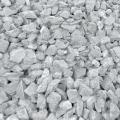Compaction coefficient of crushed stone - what is it?
The compaction coefficient of any bulk material shows how much its volume can be reduced with the same mass due to compaction or natural shrinkage. This indicator is used to determine the amount of filler both during purchase and during the construction process itself. Since the bulk weight of crushed stone of any fraction will increase after compaction, it is necessary to immediately lay down a supply of material. And in order not to purchase too much, a correction factor will come in handy.
The compaction coefficient (K y) is an important indicator that is needed not only for the correct formation of an order for materials. Knowing this parameter for the selected fraction, it is possible to predict further shrinkage of the gravel layer after loading it with building structures, as well as the stability of the objects themselves.
Since the compaction ratio represents the degree of volume reduction, it varies under the influence of several factors:
1. Loading method and parameters (for example, from what height is backfilling performed).
2. Features of transport and the duration of the journey - after all, even in a stationary mass, gradual compaction occurs when it sags under its own weight.
3. Fractions of crushed stone and grain contents of smaller size than the lower limit of a specific class.
4. Flakiness - needle-shaped stones do not give as much sediment as cuboid ones.
The strength of concrete structures, building foundations and road surfaces subsequently depends on how accurately the degree of compaction was determined.
However, do not forget that compaction on the site is sometimes performed only on the top layer, and in this case the calculated coefficient does not fully correspond to the actual shrinkage of the pillow. Home craftsmen and semi-professional construction teams from neighboring countries are especially guilty of this. Although, according to technology requirements, each layer of backfill must be rolled and checked separately.

Another nuance - the degree of compaction is calculated for a mass that is compressed without lateral expansion, that is, it is limited by the walls and cannot spread out. At the site, such conditions for backfilling any fraction of crushed stone are not always created, so a small error will remain. Take this into account when calculating the settlement of large structures.
Sealing during transport
Finding some standard compressibility value is not so easy - too many factors influence it, as we discussed above. The crushed stone compaction coefficient can be indicated by the supplier in the accompanying documents, although GOST 8267-93 does not directly require this. But transporting gravel, especially large quantities, reveals a significant difference in volumes when loading and at the final point of delivery of the material. Therefore, an adjustment factor that takes into account its compaction must be included in the contract and monitored at the collection point.
The only mention from the current GOST is that the declared indicator, regardless of the fraction, should not exceed 1.1. Suppliers, of course, know this and try to keep a small supply so that there are no returns.
The measurement method is often used during acceptance, when crushed stone for construction is brought to the site, because it is ordered not in tons, but in cubic meters. When the transport arrives, the loaded body must be measured from the inside with a tape measure to calculate the volume of gravel delivered, and then multiply it by a factor of 1.1. This will allow you to roughly determine how many cubes were put into the machine before shipping. If the figure obtained taking into account the compaction is less than that indicated in the accompanying documents, it means that the car was underloaded. Equal or greater - you can command unloading.

Compaction on site
The above figure is taken into account only for transportation. Under construction site conditions, where crushed stone is compacted artificially and using heavy machines (vibrating plate, roller), this coefficient can increase to 1.52. And the performers need to know the shrinkage of the gravel backfill for sure.
Usually the required parameter is specified in the design documentation. But when the exact value is not needed, they use average indicators from SNiP 3.06.03-85:
- For durable crushed stone of fraction 40-70, a compaction of 1.25-1.3 is given (if its grade is not lower than M800).
- For rocks with a strength of up to M600 - from 1.3 to 1.5.
For small and medium size classes of 5-20 and 20-40 mm, these indicators have not been established, since they are more often used only when decluttering the upper load-bearing layer of grains 40-70.

Laboratory research
The compaction coefficient is calculated based on laboratory test data, where the mass is compacted and tested on various devices. There are methods here:
1. Substitution of volumes (GOST 28514-90).
2. Standard layer-by-layer compaction of crushed stone (GOST 22733-2002).
3. Express methods using one of three types of density meters: static, water balloon or dynamic.
Results can be obtained immediately or after 1-4 days, depending on the study chosen. One sample for a standard test will cost 2,500 rubles, and at least five of them will be needed in total. If data is needed during the day, express methods are used based on the results of selecting at least 10 points (850 rubles for each). Plus you will have to pay for the departure of a laboratory assistant - about 3 thousand more. But during the construction of large projects it is impossible to do without accurate data, and even more so without official documents confirming the contractor’s compliance with the project requirements.
How to find out the degree of compaction yourself?
In field conditions and for the needs of private construction, it will also be possible to determine the required coefficient for each size: 5-20, 20-40, 40-70. But to do this, you first need to know their bulk density. It varies depending on the mineralogical composition, although slightly. Crushed stone fractions have a much greater influence on the volumetric weight. For calculations, you can use averaged data:
| Fractions, mm | Bulk density, kg/m3 | |
| Granite | Gravel | |
| 0-5 | 1500 | — |
| 5-10 | 1430 | 1410 |
| 5-20 | 1400 | 1390 |
| 20-40 | 1380 | 1370 |
| 40-70 | 1350 | 1340 |
More accurate density data for a specific fraction is determined in the laboratory. Or by weighing a known volume of building rubble, followed by a simple calculation:
- Bulk weight = mass/volume.
After this, the mixture is rolled to the state in which it will be used on site and measured with a tape measure. The calculation is made again using the above formula, and as a result, two different densities are obtained - before and after compaction. By dividing both numbers, we find out the compaction coefficient specifically for this material. If the sample weights are the same, you can simply find the ratio of the two volumes - the result will be the same.
Please note: if the indicator after compaction is divided by the initial density, the answer will be greater than one - in fact, this is the material reserve factor for compaction. It is used in construction if the final parameters of the gravel bed are known and it is necessary to determine how much crushed stone of the selected fraction to order. When calculated back, the result is a value less than one. But these numbers are equivalent and when making calculations it is only important not to get confused which one to take.
 Construction materials and list of works
Construction materials and list of works Proper insulation of a wooden ceiling in a private house
Proper insulation of a wooden ceiling in a private house What types of crushed stone are there?
What types of crushed stone are there?